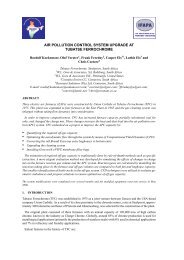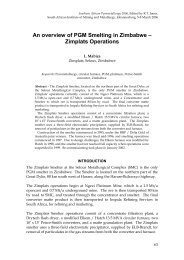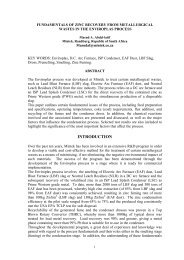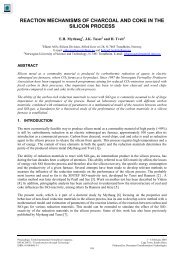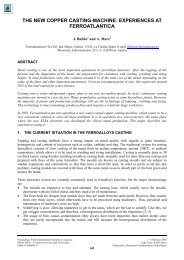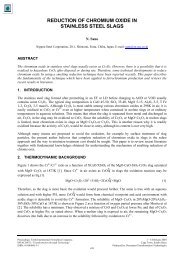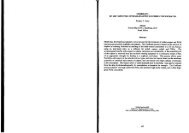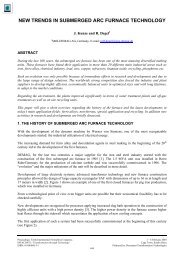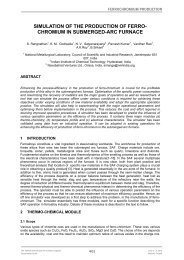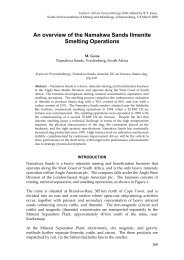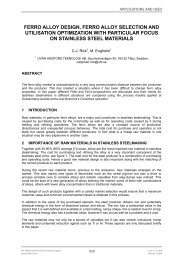Create successful ePaper yourself
Turn your PDF publications into a flip-book with our unique Google optimized e-Paper software.
Ferromanganese Smeltingsystem. The feedrate and batch mass values were all controlled manually. Energy was logged every30 minutes from the panel.The DC operation employed a “200 kW” power supply and the twin electrode mode furnaceparameters were controlled by the ‘Delta V’ control system. The total integrated energy input wasaccumulated on the control system. The two furnace transformers were each connected to one of twoDC rectifiers with a voltage and current capable of achieving a power level of about 100 to 200 kWsubject to operating conditions.3 RAW MATERIALSTypical South African Mamatwan and Wessels manganese ores types were used in the testwork.These two ore types are both mined in the Northern Cape region but differ in their mineralogy.Mamatwan type ore is rich in carbonates and has a high Mn/Fe ratio [8]. This is partly becauseBraunite I, the major component of Mamatwan type ore has considerably less iron as opposed to thehigher iron content in the predominant Braunite II mineral in the Wessels type ore. Consequently,Wessels type ore has a lower Mn/Fe ratio. Gloria ore, being of Mamatwan type and Nchwaning, aWessels type both originate from the same region [9, 10]. The chemical analyses of the raw materialsused in the smelting testwork are given in Table 1. Table 1 also includes the reductant ash analyses.The proximate analyses and particle sizes of the reductants are given in Table 2.Table 1:Particle size of the charge and chemical composition of the raw materialsDescriptionParticlesize (mm)Al 2 O 3 CaO FeO Fe MgO MnO Mn SiO 2 CO 2Gloria 10-40 0.1 12.6 - 4.8 3.9 - 37.6 6.2 -Nchwaning 10-40 0.3 6.0 - 11.1 0.3 - 48.2 2.5 -Limestone ±50 0.7 50 0.6 - 1.6 0.7 - 6 40Quartzite ±50 0.6 0.1 0.2 -
Ferromanganese Smelting4.2 Testwork at a GlanceTable 3:Summary of FeMn and SiMn submerged arc smelting campaignsParameter Unit DetailsManganese ferroalloy type HC FeMn SiMnPower supply type AC DC AC DCNumber of graphite electrodes three two three twoTest dates [week № in 2007] 18 19 39 45Total duration hours 72.7 53.7 38.5 134.3 138.2Downtime/”power off” time hours 4.2 2.1 1.9 22.6 20.9Roof refractory typeHigh-alumina castableBatch/heat/tapping numbers 4 - 22 25-40 41-54 0 - 11 12-28 1 - 26 27-48Warm-up tap number 4 25 0 1Burden melt-down numbers 23 - 29 - 49Furnace clean-out numbers 3, 24 - 30 - -Furnace dig-out number - 55 - - - 49High - [Mn/Fe ratio] Mn ore : massLow - [Mn/Fe ratio] Mn ore ratio ratio50:50 50:50 50:50 70:30 70:30 50:50Coke : Anthracite ratio, mass ratio 30:70 29:71 30:70 1:2Total manganese ore smelted ton 3.55 2.65 2.02 2.75 2.81Total reductant, kg per 100 kg Mn ore 26.9 23.8 26.9 45Quartzite quantity ton 0.11 0.08 0.06 1.1 1.1Limestone flux quantity kg - - - 275 282Total energy input MWh 8.94 11.69 13.63 16.56Total alloy produced # ton 1.30 1.85 1.16 1.22Total slag ton 1.07 1.52 1.95 1.94# Silico-manganese alloy masses corrected for dilution with iron from the tapping lance4.2.1 Summary of the HCFeMn campaign using a three-phase AC power supplyA typical recipe was chosen for the smelting of HCFeMn according to the discard-slag practice asperformed by South African industrial manganese ferroalloy producers, using typical South Africanmanganese ores, but no sinter. Initially a small amount of limestone flux was employed in the smeltingrecipe, but was changed to 5 kg of quartzite per 200 kg ore + reductant [from Tap 4] to obtain a slagbasicity ratio [(CaO + MgO)/SiO 2 ] close to the target value of 1.3 ± 0.1.The hydraulic electrode hoists of the pilot-plant furnace were manually adjusted to maintain electrodecurrents in the range of approximately 2 kA, with a transformer tap selection such that the averagetotal instantaneous power input to the furnace after the warm-up tap [i.e. from Tap 5 onwards] wasabout 120 kW. A statistical summary of the electrical operating data is given in Table 5.Tapping operations were attempted after an average of 394 kWh of energy input [“power on” tap-totaptime of 3.3 hours], or effectively approximately 192 kWh of energy when lost energy is subtractedbased on average heat losses (based on conduction through refractory lining only) of about 55 kWand a total average tap-to-tap time of 3.5 hours. The quantity of alloy tapped was on average about64 kg per tapping operation. The measured heat losses were calculated from sidewall film coolingwater flowrate and its temperature increase, whereas an estimated “unmeasured” value of 25 kW wasadded (from previous experience on this furnace) to obtain a value for the total average heat lossesper tap.Measurements were done to determine the distance between electrode tips and the furnace hearth. Asummary of these distances is given in Table 4.The Twelfth International Ferroalloys CongressSustainable Future500June 6 – 9, 2010Helsinki, Finland
Ferromanganese SmeltingTable 4:Electrode-to-hearth distances measured during AC FeMn smeltingTap/batch number Particular parameter Distance, mmElectrode number E 1 E 2 E 3Tap 18 Difference in measurement markings 170 210 210Tap 19 Difference in measurement markings 150 150 200Average from two measurements 160 180 205Standard deviation from two measurements 14 42 7Overall average 1824.2.2 Summary of the SiMn campaign using a three-phase AC power supplyFor the three-phase AC pilot test a typical industrial recipe for smelting SiMn from South Africanmanganese ores was employed, but without manganese sinter. The reductant consisted of coke andanthracite in a mass ratio of 1:2 with total reductant 45 kg per 100 kg manganese ore. The campaignwas conducted in two parts, the first with equal amounts of the two types of manganese ore, whereasin the second part, the manganese ore with the high Mn/Fe ratio was increased to 70% of thecombined manganese ore contingent. Quartzite in the recipe was 40 kg per 100 kg manganese oreand limestone 10 kg per 100 kg ore.Table 5 summarizes averages and standard deviations of tap/batch average electrical parameters E1,E2, E3, V1, V2, V3, P1, P2, P3 and total power.Table 5:Statistical summary of the electrical data for the AC FeMn and AC SiMn campaignsElectrical parameterAverage/standard deviation for tap averageHCFeMnSiMnPhase voltage V1 V2 V3 V1 V2 V3Average phase voltage, V 39.9 41.8 39.0 39.7 42.5 39.4Standard deviation for averagevoltage, V3.2 3.1 2.8 4.2 4.2 4.0Electrode current I1 I2 I3 I1 I2 I3Average electrode current, A 1834 1909 1882 1815 1810 1799Standard deviation on averageelectrode current, A178 171 192 245 255 249Power input P1 P2 P3 P-total P1 P2 P3 P-totalAverage phase and totalpower, kW40.6 45.3 34.3 120.3 39.2 47.9 39.5 126.6Standard deviation on averagephase and total power, kW9.1 10.1 8.5 11.1 12.3 12.1 11.8 14.5The target slag basicity ratio of about 0.6 was achieved. The slag MnO content varied over quite arange between 15 and 30%, with an average of 22% and a standard deviation of 4%. Huge variationsin especially the Mn and Fe analysed in the alloy samples were indicative of the effect of iron dilutionfrom the lance during extended tapping operations.At the end of the campaign, the furnace was drained as far as possible. Hereafter, the positions of theelectrode tips in relation to the furnace hearth were determined as 40 mm, 45 mm and 55 mm forelectrodes 1, 2, and 3 respectively.After the warm-up onwards, the average energy input between tapping operations was of the order of446 kWh at an average instantaneous power level of around 124 kW, giving an average tap-to-tap“power on” duration of 3.6 hours. With an average total tap-to-tap time of 4.3 hours [averagedowntime of 0.7 hours per tap] the effective average energy per tapping operation was around 232kWh, and an average total amount [slag + alloy (corrected for iron pick-up from lancing)] of 106 kg [40kg alloy] was tapped. The average heat losses by conduction through furnace refractory totaled about50 kW [calculated as the sum of 25 kW of measured and an estimated 25 kW of unmeasured heatlosses], roughly 5 kW lower than that in the HCFeMn smelting test.The Twelfth International Ferroalloys CongressSustainable Future501June 6 – 9, 2010Helsinki, Finland
Ferromanganese Smelting4.2.3 Summary of the HCFeMn campaign using a DC current power supplyFor the HCFeMn submerged-arc smelting campaign with DC current, the necessary busbar changeswere made. The furnace dome and shell after the clean-out that followed the AC FeMn test remainedin the same position. Only the roof with three apertures for the graphite electrodes was replaced withone that contained only two apertures for the twin-cathode electrodes.The DC sub-arc campaign for smelting HC FeMn started with Tap 25. The feed blend with the start-upwas the same as was used in the AC FeMn test, but a change was made in the percentage reductantwith the start of Tap 28 – the total reductant was reduced by approximately 10% from 26.9 kg per 100kg manganese ore to 23.8 kg per 100 kg manganese ore. The reason for the change was that a lot ofcarbonaceous material had been found in the material removed during the digout after the AC FeMntest. However, to be able to compare the AC and DC submerged-arc smelting of HCFeMn on thesame basis, the raw material blend was changed back to 26.9 kg total reductant per 100 kgmanganese ore from Tap 41 to the end of the DC test.A statistical summary of the electrical operating data is given in Table 6. Subsequent to the warm-uptap [i.e. from Tap 26 onwards] the average instantaneous power input from the two drives was about134 kW and tapping operations were attempted after an average of 361 kWh of energy input [averagetap-to-tap “power on” time of 2.7 hours], giving about 204 kWh of energy when lost energy issubtracted based on average heat losses (based on conduction through refractory lining only) ofabout 55 kW over an average total tap-to-tap time of 2.8 hours. The net effect was that, as with theAC HCFeMn test, the average quantity of alloy per tapping operation was about 63 kg.Several electrode-to-hearth determinations were done with the numerical average of eightmeasurements [4 per electrode] being 183 mm.4.2.4 Summary of the SiMn campaign using a DC current power supplyThe DC submerged-arc smelting campaign commenced using the same recipes used in the ACsubmerged-arc test for SiMn. The only difference was that the recipe with the larger amount of highMn/Fe ore was used in the first part [Taps 1 to 26] and the recipe with equal amounts of the twomanganese ore types in the smelting blend was used during the latter part of the test [Taps 27 to 48].Most of the tapping operations were markedly more difficult during this test as compared to the SiMnsmelting campaign using the AC setup. This is born out by an iron balance subsequent to the test thatshows that on average 5.2 kg of lance rod was used per tapping operation in the DC submerged-arcSiMn test as compared to 3.5 kg in the AC submerged-arc SiMn test. The dilution effect on the alloywas compounded by the fact that the average quantity of molten material tapped in the DC test[average total amount [slag + alloy (corrected for iron pick-up from lancing)] was about 65 kg [25 kgalloy], compared to approximately106 kg [40 kg alloy] in the AC test.The furnace control philosophy was based on current setpoint as was the case with the HCFeMnsubmerged arc campaign. The current setpoint was initially 2000 A per drive, up to Tap 8, after whichit was changed to 2500 A per drive, in order to get better stability with respect to power input. Table 6summarizes electrical parameters, specifically averages and standard deviations of Tap averages ofthe parameters E1, E2, V1, V2, P1, P2, and total power.The average heat losses [by conduction through furnace refractory] totaled 65 kW – these lossesincreased during the course of the campaign with an average of 60 kW for the first part and 72 kW forthe second part. After the warm-up batch [Tap 1], i.e. from Tap 2 onwards, the average energy inputbetween tapping operations was of the order of 329 kWh at an average instantaneous power level ofaround 142 kW, giving an average tap-to-tap “power on” duration of 2.3 hours. With an average totaltap-to-tap time of 2.7 hours [average downtime of 0.4 hours per tap] the effective average energy pertapping operation was around 152 kWh, compared to 232 kWh for the AC submerged-arc SiMncampaign. The ratio of these values for the effective average energy per tapping operation is of thesame order of the ratio of average molten material tapped per tapping operation between the twocampaigns.The Twelfth International Ferroalloys CongressSustainable Future502June 6 – 9, 2010Helsinki, Finland
Ferromanganese SmeltingAfter Tap 49 [burden meltdown and tapping], the positions of the electrode tips in relation to thefurnace hearth were determined. These distances were 45 mm and 60 mm for electrodes 1 and 2respectively.Table 6:Statistical summary of the electrical data for the DC FeMn and DC SiMn campaignsHCFeMnSiMnElectrical parameter PeriodAverage/standarddeviation for tapaveragePeriodAverage/standarddeviation for tapaverageVoltage Taps V1 V2 Taps V1 V225 - 38 26.5 26.5 2 - 9 35.1 36.9Average electrode39 - 41 25.2 23.3 10 - 26 29.1 28.3voltage, VStandard deviation foraverage voltage, V42 - 54 27.2 26.3 30 - 49 29.0 27.425 - 38 5.8 6.7 2 - 9 9.1 10.039 - 41 3.1 2.1 10 - 26 6.2 6.842 - 54 7.6 7.5 30 - 49 7.9 6.3Current I1 I2 I1 I225 - 38 2457 2457 2 - 9 1987 1988Average electrodecurrent, AStandard deviation onaverage electrode39 - 41 2456 2497 10 - 26 2484 249642 - 54 2505 2503 30 - 49 2494 249225 - 38 55 55 2 - 9 94 5039 - 41 212 150 10 - 26 114 33current, A 42 - 54 12 23 30 - 49 44 48Power P1 P2 P-total P1 P2 P-total25 - 38 64.6 67.9 132.5 2 - 9 69.4 75.7 145.1Average electrode andtotal power, kW39 - 41 60.8 61.1 121.8 10 - 26 72.1 73.9 146.042 - 54 69.1 69.1 138.2 30 - 49 72.3 71.6 143.925 - 38 15.5 16.9 23.6 2 - 9 19.8 21.0 29.539 - 41 3.7 3.4 5.4 10 - 26 17.5 17.2 26.8Standard deviation onaverage electrode andtotal power, kW 42 - 54 20.8 19.7 29.9 30 - 49 21.1 16.9 27.05 TEST RESULTS5.1 Comparison between Ferromanganese Smelting in AC and DC Submerged-arc Furnaces5.1.1 Refractory temperaturesThe average sidewall and hearth temperatures for the two ferromanganese smelting tests aresummarized in Table 7. The hearth thermocouple temperature for the AC HCFeMn campaignincreased up to a temperature of around 235ºC and decreased to about 210ºC towards the end. Afterwarm-up of the DC FeMn test, the corresponding hearth thermocouple temperature remained steadyat about 235ºC up to the end of the test.Table 7:Sidewall and hearth temperatures for AC and DC submerged-arc smelting of HCFeMnCampaign Temperatures Unit Sidewall refractory lining Hearth liningRefractory type Al 2 O 3 -MgO castable MgO/CaO dry rammingDesignation T 1 T 2 T 3 T 1 T 2AC FeMn Numerical average º C 304 254 262 - 197Standard deviation º C 20 16 37 - 34DC FeMn Numerical average º C 337 138 291 315 229Standard deviation º C 42 8 34 9 125.1.2 Metallurgical parametersThe metallurgical comparison between the AC and DC submerged-arc smelting tests on standardferromanganese is summarized in Table 8.The Twelfth International Ferroalloys CongressSustainable Future503June 6 – 9, 2010Helsinki, Finland
Ferromanganese SmeltingTable 8:Comparison of metallurgical parameters between AC and DC HC FeMn campaignsMetallurgical parameter Specifics Units Details/valuesSmelting campaign AC DCTap numbers where alloy samples were contaminated 13 to 16 25 to 28Selected periods/taps 7 - 12 17 - 22 29 - 40 41 - 54Average alloy composition % Mn 77.2 77.1 78.0 78.7% Fe 15.6 15.4 15.9 15.5% Si 0.6 1.0 0.7 0.9% C 6.6 6.5 6.9 6.6Standard deviations on alloy composition% Mn 1.6 0.6 1.6 2.9% Fe 0.4 1.0 0.8 0.9% Si 0.3 0.6 0.6 0.5% C 0.2 0.4 0.2 0.3Average slag composition % MnO 27.4 25.5 25.4 23.7Slag basicity mass ratio [(CaO + MgO)/SiO 2 ] 1.3 1.3 1.3 1.4Standard deviations on slag composition and % MnO 6.3 3.6 7.4 6.8slag basicity mass ratio [(CaO + MgO)/SiO 2 ] 0.1 0.1 0.1 0.1Slag – to – alloy mass ratio 0.82 0.82Average tapping temperature º C 1490 1495Standard deviation on tapping temperatures º C 50 51Manganese deportment To alloy % 82.1 ± 0.5 83.4 ± 0.5To slag % 17.9 ± 0.5 16.6 ± 0.5Mn – to – Fe mass ratio Feed 5.4 5.4Alloy 5.0 5.0Energy consumption process kWh/kg alloy 3.15 3.23Actual # kWh/kg alloy 6.01 5.59Graphite electrode consumption kg/MWh 8.9 8.95.2 Comparison between SiMn Smelting in AC and DC Submerged-arc Furnaces5.2.1 Refractory temperaturesThe average sidewall and hearth temperatures for the two SiMn smelting tests are summarized inTable 9. Towards the end of the DC SiMn campaign, the hearth temperature T 1 did not stabilize butapproached 900ºC indicating that hearth erosion was extensive and failure thereof imminent.Table 9:Sidewall and hearth temperatures for AC and DC submerged-arc smelting of SiMnCampaign Temperatures Unit Sidewall refractory lining Hearth liningRefractory type Fused-grain MgO-Cr 2 O 3 bricks MgO/CaO dry rammingDesignation T 1 T 2 T 3 T 1 T 2AC SiMn Numerical average º C 61 45 41 204 167Standard deviation º C 7 6 12 7 22DC SiMn Numerical average º C 38 54 56 465 192Standard deviation º C 4 6 7 143 28Sidewall thermocouples used with the SiMn tests showed lower temperatures than those in theHCFeMn tests due to their position – only about 1 to 2 cm into the cold face of the bricks as opposedto being cast about halfway into the MgO-Al 2 O 3 lining used in the HCFeMn tests. Further confirmationthat there had not been any erosion of the MgO-Cr 2 O 3 bricks during the SiMn tests was the fact thatthe Cr 2 O 3 levels in the slag were very low.The Twelfth International Ferroalloys CongressSustainable Future504June 6 – 9, 2010Helsinki, Finland
Ferromanganese SmeltingThe Twelfth International Ferroalloys CongressSustainable Future507June 6 – 9, 2010Helsinki, Finland
Ferromanganese SmeltingThe Twelfth International Ferroalloys CongressSustainable Future508June 6 – 9, 2010Helsinki, Finland



